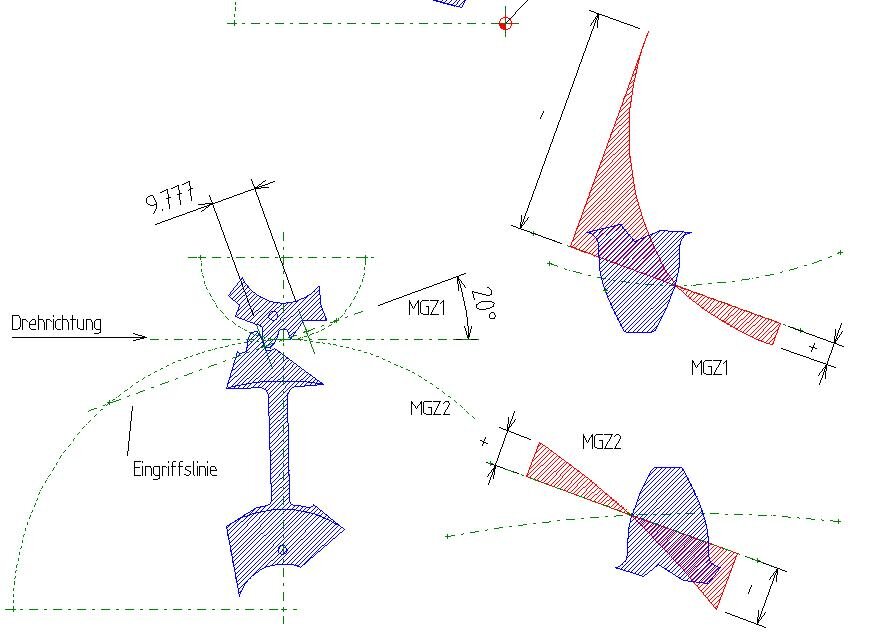Im Gegensatz zur typischen Uhrmacherkunst die früher fast ausschliesslich Zykloide und Hypozykloide Verzahnungen verwendeten (infolge geringerer Reibung bei einem Antrieb vom langsamen ins schnelle) haben die Zahnräder des Telluriums eine Evolventen Verzahnung. Diese bietet bei dieser Verwendung nur Vorteile. Die Evolventen Verzahnung hat eine Gerade als Eingriffslinie. Die Eingriffslinie schneidet die Tangente im Wälzpunkt in einem rechten Winkel. Sie ist also zugleich Berührungsnormale. Die Eingriffslinie tangiert ebenfalls die beiden Grundkreise der Räder. Beim Umkehren der Drehrichtung ändert sich die Eingriffslinie spiegelbildlich. Die Krümmung der Zahnflanken ρ (rho) sind im jeweiligen Berührpunkt Unterschiedlich gross, ihre Summe jedoch bleibt konstant. Die Zahnflanken wälzen sich nicht nur aufeinander ab, sondern Gleiten auch.
In contrast to the typical watchmaking art, which used to use almost exclusively cycloid and hypocycloid gearing (due to lower friction in a drive from slow to fast), the gears of the tellurium have a evolvenent gearing. This only offers advantages in this use. The Evolventen toothing has a straight line as an intervention line. The intervention line intersects the tangent at a right angle at the rolling point. It is therefore at the same time a normal of contact. The intervention line also affects the two basic circuits of the wheels. When the direction of rotation is reversed, the line of intervention changes in a mirror image. The curvature of the tooth flanks (rho) are different in the respective touch point, but their sum remains constant. The tooth flanks not only roll off on each other, but also glide.
Die Flankenpunkte A1 und A2 kommen in A zur Berührung, die Flankenpunkte B1 und B2 in B. Demzufolge arbeitet in diesem Abschnitt der Flankenteil A1B1 mit dem Flankenteil A2B2 zusammen. Da beide verschieden lang sind, kennzeichnet die Längendifferenz den Gleitweg. Der kürzere Flankenteil wird stärker abgenützt. Die Gleitgeschwindigkeit vg ist die Differenz der beiden Tangential-geschwindigkeiten vt1 und vt2, und zwar vg = vt1 – vt2 für Flankenpunkte an MGZ1, vg = vt2 – vt1 für Flankenpunkte an MGZ2. Unter spezifischem Gleiten versteht man also das Maß für das Gleiten der Zahnflanken und somit das Verhältnis der Gleitgeschwindigkeit zur Tangentialgeschwindigkeit des jeweiligen Berührpunktes der entsprechenden Flanke. Im Wälzpunkt ist die Differenz der beiden Tangentialgeschwindigkeiten gleich null und somit findet dort kein Gleiten statt.
The flank points A1 and A2 come into contact in A, the flank points B1 and B2 in B. Consequently, in this section of the flank part A1B1 cooperates with the flank part A2B2. Since both are different in length, the length difference indicates the sliding path. The shorter flank part is worn out more heavily. The sliding velocity vg is the difference between the two tangential speeds vt1 and vt2, namely vg = vt1 – vt2 for flank points at MGZ1, vg = vt2 – vt1 for flank points at MGZ2. By specific gliding one means the measure for the sliding of the tooth flanks and thus the ratio of the sliding velocity to the tangential velocity of the respective touch point of the corresponding flank. In the rolling point, the difference between the two tangential velos is zero and therefore no sliding takes place there.
Für die Berechnungen des spezifischen Gleitens wurden die unten aufgeführten Formeln verwendet. Alle Zahnflanken wurden ohne eine Profilverschiebung hergestellt. Die Berechnung wurde nicht nur für einen einzelnen Punkt der Eingriffsstrecke gerechnet, sondern für den ganzen Eingriffsbereich.
The formulas listed below were used for the calculations of the specific slide. All tooth flanks were manufactured without a profile shift. The calculation was calculated not only for a single point of the course of the procedure, but for the entire scope of the procedure.
Das Verhältnis der Zähnezahl z2 des Grossrades zur Zähnezahl z1 des Kleinrades ist das Zähnezahl Verhältnis u. Das unten stehende Berechnungsbeispiel zeigt die Werte der spezifischen Gleitung am Punkt 3.82 mm der Eingriffslinie des Zahnradpaares MGZ_1 und MGZ_2.
The ratio of the number of teeth z2 of the large wheel to the number of teeth z1 of the small wheel is the number of teeth ratio u. The calculation example below shows the values of the specific glider at point 3.82 mm of the gear pair's intervention line MGZ_1 and MGZ_2.
Die Berechnung der spezifischen Gleitung aller Zahnradpaare wurde mit EXCEL realisiert. Hier
wurde der ganze Bereich der Eingriffslinie berücksichtigt. Wobei zu erwähnen bleibt dass zur Erzeugung der Funktion ein Inkrement von 0.05 mm gewählt wurde. Die Funktion des spezifischen Gleitens kann mit einer Polynomfunktion sechsten Grades schon sehr genau angenähert werden.
The calculation of the specific gdirect of all gear pairs was realized with EXCEL. Here, the whole area of the intervention line was taken into account. It should be noted that an increment of 0.05 mm was chosen to generate the function. The function of the specific gliding can be approximated with a sixth degree polynomial function.












